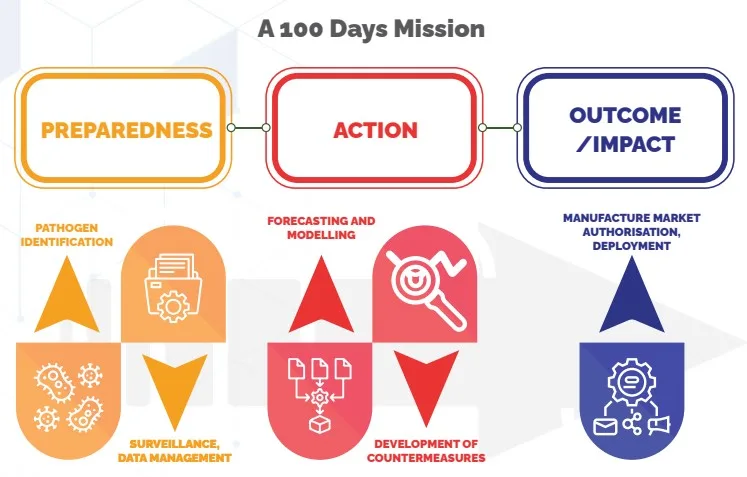Syllabus: GS2/Government Policy and Intervention; Health
Context
- Recently, the NITI Aayog released an Expert Group report titled ‘Future Pandemic Preparedness and Emergency Response —A Framework for Action’, focusing on public health emergencies or pandemics.
Background: Blueprint for Preparedness
- The expert group behind the ‘Future Pandemic Preparedness and Emergency Response (PPER) — A Framework for Action’ recognised that COVID-19 wouldn’t be the last pandemic we face.
- Given the ever-changing planetary dynamics—ecology, climate, and interactions between humans, animals, and plants—there is a need to be ready for new infectious threats.
- In fact, the World Health Organization (WHO) has warned that 75% of future public health threats are likely to be zoonotic (originating from animals).
Key Objectives of Report
- NITI Aayog formed an Expert Group with a clear mission: create a robust framework for future pandemic preparedness and emergency response, to address the above emergencies.
- Their task was to examine how COVID-19 was managed both nationally and globally, learn from successes and challenges, and identify key gaps to enhance our readiness for any health crisis.
Key Recommendations (Four Pillars of Preparedness)
- Governance, Legislation, Finance and Management: Effective governance structures, legal frameworks, financial mechanisms, and management strategies are crucial.
- A well-defined SOP manual for rapid response to be prepared Setting up of a special PPER Fund for all activities of surveillance, data management, forecasting and modelling, research, innovation and manufacture, development of countermeasures, infrastructure and capacity building.
- Data Management, Surveillance and Early Predictive Warning, Forecasting and Modelling: Timely data collection, surveillance systems, and predictive models allow us to detect outbreaks early. This information is vital for swift decision-making.
- Research and Innovation, Manufacturing, Infrastructure, Capacity building/Skilling: Investing in research, innovation, and domestic manufacturing capacities is essential. We need to develop diagnostic tools, treatments, and vaccines swiftly.
- Partnership, Community engagement including risk communication, Private sector partnerships, and international collaborations: Strengthening healthcare capacity, training healthcare workers, and engaging communities are vital. International collaboration ensures knowledge sharing and resource pooling.
Other Recommendations
- A separate Public Health Emergency Management Act (PHEMA) is proposed to facilitate the management of any public health crisis beyond epidemics, including non-communicable diseases, disasters, and bioterrorism, and should be in place for a developed country.
- Indian Regulatory System: There is a need for global harmonisation of regulatory norms to allow acceptance of regulatory data across the world’s recognised regulatory authorities and a common framework for innovative technologies and accelerated response for emergency approval.
- The regulatory authority in India (CDSCO) needs special powers through legislation and requires technical competence strengthening and autonomy in functioning to meet these requirements.
100-Day Action Plan
- The report emphasises that the first 100 days of an outbreak are critical. During this window, there is a need to have strategies and countermeasures ready.
- The report provides a detailed roadmap for preparedness, including how to track, test, treat, and manage outbreaks effectively.

India’s Efforts and Lessons Learned
- India’s response to the SARS-CoV-2 pandemic involved several key initiatives, like:
- Novel Counter-Measures: Funding for industry and researchers, shared resources, and policy guidelines.
- Digital Tools: Investments in pandemic response tools and vaccination data management.
- Global Collaborations: Partnerships with other countries and organisations.
| Event/Outbreak and Their Learning – SARS in 2003 1. Need for International legally binding rules/ regulations. 2. Detection of infection among exposed persons is a challenge during the initial phase. 3. Need for core capacities for screening, sample collection and quarantine facilities at international airports. – Avian Flu (H5N1) 1. An effective strategy of surveillance of at-risk populations and culling sick birds was developed as a coordinated surveillance and response plan for both human and animal sectors. 2. A standing committee on zoonosis was established following avian influenza –H1N1 Pandemic (pandemic declared as Public Health Emergency of International Concern) – Countries were developing core capacities as per International Health Regulations (IHR) 2005 at points of entry and inside the country for surveillance and response. 1. IHR (2005), a legally binding regulation, was in place. – Countries adopted public health measures like screening at POEs, early detection of suspects, quarantine, contact tracing of suspect surveillance and management of cases in isolation in dedicated wards. 1. Public health measures were helpful in mitigating and delaying the entry of infection. – Need for coordinated surveillance between Points of entry and in country surveillance systems. – Ebola Outbreaks (2014-16) and (2018-21) 1. Efforts to control these outbreaks involved screening, surveillance of exposed, contact tracing, data management, laboratory testing, and health education, including use of PPEs. 2. Public health efforts were much more effective, limiting entry into the country. – MERS-CoV 1. Zoonotic diseases, particularly highly infectious diseases that spread via respiratory/ droplets route could be challenging to prevent. 2. Most of the threats leading to pandemics were due to novel viruses of zoonotic origin, possibly transmitted through the human animal interface. 3. Infectious diseases having a respiratory mode of transmission are dangerous. – Zika Virus Disease 1. It is a disease with over 80% asymptomatic cases and mild clinical symptoms with full recovery cannot be prevented using public health measures directed towards travellers. 2. Effective vector surveillance and control is essential to prevent entry and transmission of vector-transmitted diseases. 3. Need for multi-sectoral collaborative surveillance |
Conclusion
- In a world where pandemics are no longer rare events, ‘Future Pandemic Preparedness and Emergency Response (PPER) — A Framework for Action’ serves as a beacon—a roadmap to navigate the challenges ahead.
- It’s a reminder that preparedness isn’t just about reacting; it’s about proactive planning, collaboration, and resilience.
Previous article
CBI as a ‘Caged Parrot’: Supreme Court
Next article
Delay in Appointment of NHRC Chairperson